Welcome to the Travel Forecasting Guidelines for Selecting Travel Forecasting Methods (TFGuide).
The purpose of TFGuide is to evaluate the properties of travel forecasting methods and their value in addressing transportation planning requirements for specific plans and programs. This tool provides the first aspect of an overall forecasting process, which typically includes these five:
- Properties of the forecasting methods
- Adequacy of current observed data to test the methods
- Successful testing of the methods to demonstrate their grasp of current travel patterns
- Reasonableness of inputs (demographics, infrastructure and operations) used in the forecasts
- Plausibility of the forecasts for the proposed project
TFGuide is not intended to inform users about data assembly, testing, or evaluation of the travel forecasting modeling process, but instead is focused on identifying the preferred forecasting methods that can meet the indicated planning requirements and produce the desired performance metrics while accounting for resource constraints. TFGuide provides resources and recommendations for evaluating travel forecasting methods that are prioritized based on how well they meet the user-defined planning needs and constraints. Note that the timeline and cost estimates used in TFGuide only include analysis work, and some plans and projects may require costs for non-analytical work. The Federal Transit Administration suggests organizations seeking Capital Investment Grants contact FTA to discuss forecasting methods.

Committee Membership
With notes on which roles and teams each member participates on.
Ready to volunteer? Scroll down for opportunities for helping out and learning about committee membership.
Are we missing your participation somewhere? Let us know!
Katherine Asmussen: Paper Review Coordinator; Younger Member Liason
Pedro Camargo : Integrated Modeling Subcommittee Chair
Tierra Bills : Research Coordinator, Paper Review Team
Michelle Bina: Statewide Modeling Subcommittee Chair
Charisma Choudhury
Sevgi Erdogan
David Hensle: Chandra Bot Coordinator
Cinzia Cirillo
Aditi Misra: Equity Initative Lead
Marty Milkovits : Decision-Making under Deep Uncertainty Initative Lead
Bo Wen: Community Coordinator
Baloka Belezamo: Paper Review Coordination Team
Latifa Oukhellou: Research Roadmap Maintainer
Ramin Shabanpour: Vice Chair Statewide Modeling
Franchesca Taylor: Research Roadmap Maintainer
Andisheh Ranjbari: Deputy CRC
Like Liu: Committee Communications Coordinator
Gregory Macfarlane: Technology Transfer Subcommittee Chair
Rolf Moeckel : Technology Transfer Subcommittee
Elizabeth Sall: Chair
Bhargava Sana: Travel Forecasting Resource Committee
Matt Stratton: Technology Coordinator; Technology Transfer Subcommittee
Flavia Tsang: Emerging Methods Subcommittee co-chair; Decision-making under Uncertainty co-lead.
Prateek Bansal
Alex Bettinardi: Newsletter Coordinator
Amy Hofstra: Research Initiative Lead
Abigail Donkor: LinkedIn Coordinator
Joseph Kaylor: Cooperative Research Program Coordinator; Workshop Developer
Michael Hyland
Atiyya Shaw: Research Initiative Lead
Krishna Murthy Gurumurthy
Ruijie Bian: Research Initiative Lead
Volunteer Roles + Teams
Each committee member is expected to actively participate in a volunteer role and/or team – but you do not need to be a member in order to volunteer!
Blue is where v olunteers are n eeded!
Chair : Manage overall operations of the committee – Elizabeth Sall
Vice- Chair: Serves as back-up and partner to the chair - TBD
Emerging Methods Subcommittee Chair : Manage the subcommittee on emerging methods – Flavia Tsang / Naveen Eluru
Integrated Modeling Subcommittee Chair : Manage the subcommittee on Integrated Modeling – Pedro Camargo
Integrated Modeling Subcommittee Vice-Chair: Serve as back and partner to subcommittee chair.
Technology Transfer Subcommittee Chair : Manage the subcommittee on technology transfer, including the Travel Forecasting Resource – Greg MacFarlane ( needed: incoming chair )
Technology Transfer Subcommittee Vice-Chair : Serve as back and partner to subcommittee chair ( needed ).
Statewide Modeling Subcommittee Chair: Manage the subcommittee on Statewide Modeling – Michelle Bina
Statewide Modeling Subcommittee Vice-Chair: Serve as back and partner to subcommittee chair ( needed ). .
Newsletter Coordinator: Responsible for the newsletter publication process and editor schedule - Alex Bettinardi
Newsletter Editors : Tasked with curating content for a specific newsletter issue and overseeing its publication - William Wong
Research Roadmap Maintainer: works with initiative leads, emerging methods committee, and industry stakeholder to regularly vet and update the research roadmap with the most important and pressing questions that need to be answered/knowledge that needs to be gained - Latifah Oukhellou and Franchesca Taylor
Research Initiative Lead: Shepherds a specific research initiatives to useful outcomes; making sure it is: asking useful and well-scoped questions; involves the appropriate initiatives/subcommittees/other committees/disciplines; has an action plan that is relevant for that research question ; executes on that action plan – Ruijie Bian, Amy Hofstra, Attiya Shaw
Meeting Coordinator : Develop meeting schedules + agendas ; Maintain + publish committee meeting notices, agendas + minutes ( needed )
Community Coordinator : Maintain current contact information, affiliations, demographics and interest areas for all members, friends, and volunteers via regular (annual) surveys – Bo Wen
Communications Coordinator (CCC): Disseminates information on committee activities and topics of interest via regular email and committee website including the calendar of upcoming and related conferences – Like Liu
Research Coordinator (CRC) : Manage the committee's research agenda and delegation of activities to support it – Tierra Bills
Deputy CRC: Backup to CRC; thought-partner to CRC; leads various research special projects.
Cooperative Research Program Coordinator : Manage the committee's interaction with NCHRP and TCRP programs – Joseph Kaylor
Website Coordinator: Makes sure website and calendars are working, up to date with content, removes older content. Helps specific initiatives post content. – Matt Stratton
Paper Review Coordinator: Manage paper review process – Katherine Asmussen
Chandra-Bot Coordinator: Manage Chandra-Bot Initiative – David Hensle
Equity Initiative Coordinator: Manage Equity Initiative - Aditi M i sra
Uncertainty Initiative Coordinator: Manages the Uncertainty Initiative – Marty Milkovits w/ Flavia Tsang
LinkedIn Coordinator: Responsible for maintaining our LinkedIn group page, posting announcements, and ensuring frequent updates and engagement - Abigail Donkor
Decision-Making under Deep Uncertainty (DMDU) Initiative
Volunteers to contribute to each of the challenge areas .
Equity Initiative Team
Scope is in development.
Chandra-Bot Initiative
Rigorously evaluate how well we evaluate each others' work!
Always looking for committed volunteers.
Integrated Modeling Subcommittee
Actively participate in and support the activities of the Subcommittee.
Emerging Methods Subcommittee
Statewide modeling subcommittee, technology transfer subcommittee.
Actively participate in and support the activities of the Subcommittee . Meets monthly with work on the resource completed between meetings.
Paper Review Coordination Team
Support the Paper Review Coordinator in assigning reviewers to papers and managing the paper review process. Work typically peaks mid-August.
Research Coordination
Support the Research Coordinator in maintaining a research roadmap and prioritizing calls for papers, research needs statements, etc.
Committee Membership Process
We just completed our triennual membership rotation in Spring 2024 and expect to commence revieweing applications for our next rotation cycle in Fall 2026.
Express an Interest in Committee Membership
Volunteer for a Role
Express an Interest in Volunteering
Committee Friends
Become a Committee Friend
Other Travel Forecasting Communities
Zephyr Foundation's mission is to advance rigorous transportation and land use decision-making for the public good by advocating for and supporting improved travel analysis, and facilitating its implementation.
Zephyr maintains a twitter feed , slack channel for conversations, and a LinkedIn page . Past recorded events are available on its YouTube channel.
International Association of Travel Behavior Research
The Travel Modeling Improvement Program (TMIP) maintains a form/listserv which has served as the hearth of the travel forecasting community for decades.
Young Member Communities
Trb data, planning, and analysis group, young member subcommittee , to get involved, complete the email sign up form or contact emily lindsey ( [email protected] ) for more details, or visit the subcommittee website . .
- View Record

Research in Progress
Travel Forecasting Resource with TRB and Travel Analysis Metadata
The National Cooperative Highway Research Program and the Transportation Research Board (TRB) Travel Forecasting Resource are developing broad spectrum resources for travel forecasting and analysis. Feedback from lead modeling agencies during peer reviews requested additional context information to efficiently fit the modeling tool to fit agency needs and priorities. This effort will develop metadata and search tools to assist modelers in identifying data and methods that are specific to their application context. The TF Resource is a travel demand modeling reference written by travel modelers for travel modelers. It is hosted by TRB and overseen by Special Committee ADB45 per the recommendations from Special Report 288. These funds will be made available to TRB under a grant to develop content and manage the reference.
- Status: Active
- Funding: $149936
Federal Highway Administration
Sarmiento, Mark
National Academy of Sciences
- Start Date: 20160727
- Expected Completion Date: 0
- Actual Completion Date: 0
Subject/Index Terms
- TRT Terms: Metadata ; Traffic forecasting ; Traffic models ; Travel demand
- Subject Areas: Data and Information Technology; Highways; Planning and Forecasting;
Filing Info
- Accession Number: 01669014
- Record Type: Research project
- Source Agency: Department of Transportation
- Files: RIP, USDOT
- Created Date: May 15 2018 12:00PM

Purpose of project-level travel forecasting
Elements of a forecast
Project types
Defining forecast requirements
Identifying analysis years
Geographic scope of analysis
Level of detail required in the analysis
Tool Requirements and Technical Resources
Other requirements
Page categories
Needs Review
Project Level Traffic Forecasting
This page is part of the Category [.
Go to Project-level traffic forecasting topic page.
The purpose of these guidelines is to describe both best practice and acceptable practice for performing project-level traffic forecasts for the state DOT's and similar agencies. The guidelines describe a number of techniques and options that are all acceptable within their intended scope, specific to the technique. Techniques include:
- Custom travel forecasts using conventional three-step or four-step travel forecasting software;
- Refinement of existing travel forecasts or of new forecasts from existing models; and
- Statistical analysis of time series.
To the extent possible these guidelines are consistent with national standards as described in these source reports:
- “Analytical Travel Forecasting Approaches for Project Level Planning and Design,” NCHRP Report 765 , which is an update of NCHRP Report 255;
- FHWA’s “ Travel Model Validation and Reasonableness Checking Manual II ”
- TRB’s " 2010 Highway Capacity Manual "
These source reports are considered essential for fully describing procedures and techniques; therefore, key sections of these source reports are incorporated into these guidelines by reference. In addition the guidelines benefit from a review of state DOT travel forecasting guidelines, especially:
Additional back ground material on conventional or advanced travel forecasting may be found in:
In some cases more than one technique might satisfy the requirements of the forecast. In those instances, the analyst is expected to use professional experience to choose the technique that best fits the available budget, matches the time horizon of the project, correctly applies to the spatial extent of the project, provides sufficiently robust results, has sufficient accuracy and has all the necessary data and software requirements.
Many highway projects require much more precise and detailed traffic forecasts than are typically performed for evaluating regional transportation plans. An existing regional planning model may still be used for project forecasts. However, the model must be evaluated to determine if its outputs meet the detail and accuracy requirements of the project. In many cases, outputs from regional planning models can be sufficiently improved by taking them though one or more refinement steps. A refinement process uses ground data to adjust or disaggregate regional model outputs.
# Elements of a forecast
A project-level traffic forecast for a highway project consists primarily of traffic volumes and traffic speeds on roads in some future year. Ordinarily, there will be at least two forecasts for comparison: one forecast with the project and one forecast (“do nothing”) without the project. In addition, both of these forecasts may be repeated for different future scenarios -- a scenario being a future state of the transportation system with variable conditions that are beyond the definition of the project. Additional forecasts may be required when there is more than one project alternative.
(opens new window)
(opens new window) , queue lengths, benefit-cost ratios, pavement conditions and noise levels.
# Project types
A highway project may range in scope from several miles of new freeway to spot improvements to individual road segments or intersections. These guidelines are limited to those highway projects that have at most modest geographical scope as to their impacts, that is, projects whose major impacts affect an area substantially smaller than a county, thereby excluding those projects that are more appropriately evaluated with a regional travel model. Examples of project components covered by these guidelines are:
- Intersection geometric design changes
- Signalization changes
- Access management
- Lane widening (increasing the number of through lanes)
- Road diet (decreasing the number of through lanes)
- Other cross-section modification
- New facilities, including bypasses
- Detour/diversion analysis for work zones traffic planning
- Travel demand management
- Site impact analysis
- New pavements
Projects may consist of many components, sometimes combining two or more items from the above list. For example, a project under the “Complete Streets” initiative in Hawaii might involve reducing or increasing the number of lanes, adding bike lanes and sidewalks, changing intersection geometry, and changing signalization, among several options.
Transit or non-motorized options are included only to the extent that they might be affected by or bundled with a change to the highway system. A highway project could include both physical and operational aspects.
# Defining forecast requirements
(opens new window) describes those requirements in some depth.
# Identifying analysis years
All the analysis years of the project need to be identified by their role in the project evaluation and the number of years into the future. The table below is a suggested way to describe those years.
Definition of Analysis Years (Source: “Interim Guidance on the Application of Travel and Land Use Forecasting in NEPA”)
A forecast for the base model year or project year is required for validation purposes. In addition, forecast years should be further categorized as to whether fundamental inputs to the forecasting process might vary significantly. These categories were defined in NCHRP Report 765 :
- Short range (no appreciable change in trip generation or trip distribution);
- Interim (no appreciable change in trip distribution); and
- Long range.
Consequently, whether a project is short range, long range or interim depends more upon the variable nature of travel demands than on the actual time elapsed from the project year.
For example, Hawaii uses these time horizons beyond the opening year for its routine forecasts:
- 5 years for maintenance projects, considered to be interim;
- 10 years for resurfacing projects, considered to be long range; and
- 20 years for new highways or changes in geometric design for existing highways, also considered to be long range.
Examples of short-range “projects” are site impact assessments and work-zone traffic planning.
When a forecast year for the project fails to correspond to the forecast year of a regional plan, interpolation or extrapolation of the regional forecast results may be necessary to resolve the conflict.
# Geographic scope of analysis
The choice of forecasting technique also depends upon the expanse of the impact area of the project, referred to as the geographic scope. The geographic scope of a project forecast depends both upon the size of the area of impact and the types of trips being made in and though the area. For this discussion, trips are categorized as being internal-to-internal (I-I), internal-to-external (I-E), external-to-internal (E-I), or external-to-external (E-E).
NCHRP Report 765 defines these areas:
- Site. A site contains one or more trip generators in a single development. A site has no significant internal traffic and no through traffic, thus all trips are exclusively I-E or E-I. A site is most conveniently represented within a modeling context as consisting of one or more parking lots.
- Corridor. A corridor is focused on a single street, as represented by one or more highway segments strung end-to-end. Similar to a site, a corridor has no significant internal traffic. Traffic can move through, in or out of a corridor in a variety of directions, depending upon the type and variety of cross-streets. Trips may be assumed to be I-E, E-I or E-E. An individual road segment is classified as a corridor. Small corridors, such as single street segments, may be assumed to have only E-E traffic, if the number and sizes of adjacent trip generators are small.
- Small area. A small area encompasses sizeable tracks of land, which can generate traffic; however, traffic volumes on streets within a small area are dominated by external flows (E-E, E-I or I-E), but may contain moderate amounts of strictly internal traffic (I-I).
- Wide area. A wide area covers a large enough expanse that internal traffic (I-I) is a significant percentage of all traffic and needs to be carefully modeled. Wide area models are similar in structure to regional models, but may not necessarily cover a whole region. In addition, any project for which internal traffic is important (such as some access management projects), should be considered wide area, regardless of the actual expanse of the impact area.
# Level of detail required in the analysis
Project-level traffic forecasts can vary in detail. In some cases details will need to be obtained by a refinement step, because the forecasting techniques do not themselves contain the necessary prerequisites. Types of detail for project-level traffic forecasts were described in NCHRP Report 255 and then adopted by NCHRP Report 765 .
- Functional class detail. Regional travel forecasting models rarely include functional classes lower than minor arterial. Some project-level traffic forecasts may require collectors, selected local streets and driveways.
- Daily temporal detail. Many regional travel forecasting models do forecasts for a full 24 hours of a typical weekday. Some other regional travel forecasting models do forecasts for multiple-hour peak periods. Project-level traffic forecasts often need forecasts for peak hours. In rare cases, forecasts might be needed for time periods of less than one hour, such as those forecasts that can be achieved with dynamic traffic assignments.
- Vehicle class detail. Many regional travel forecasting models have just one or two vehicle classes (automobile and/or truck). Some project level traffic forecasts, such as those done for pavement analysis, may require several vehicle classes.
- Turning movement detail. Regional travel forecasting models are known to be poor in their turning movement forecasts. However, some projects, such as those involving changes to traffic controls, require good turning movement forecasts.
- Directional split detail. Some AADT forecasts for individual road segments are bidirectional, because traffic counts that underlie the forecast are bidirectional. Additional information may be necessary to determine the correct directional split for the forecast.
- Speed detail. Many regional travel forecasting models are designed to provide the best possible estimates of traffic volumes, but these models may not have been validated for speeds or travel times. Additional post-processing may be required to achieve reliable speed or travel time estimates. Post processing may be accomplished with the “2010 Highway Capacity Manual ” or similar procedures that are consistent with well-established traffic theory.
# Tool Requirements and Technical Resources
Tools for project-level forecasts are selected mainly on the basis of the technical resources that might be available for applying those tools. The existence or lack of existence of these resources will dictate which techniques are most appropriate. These technical resources were defined in NCHRP Report 765 :
- Urban travel model
- Urban travel model, outputs only
- O-D matrix from survey
- O-D matrix from model
- Recent mainline traffic counts, all vehicles together (also by vehicle class)
- Recent mainline traffic counts, broken out by vehicle classes
- Recent intersection counts
- Recent speeds or travel times
- Historical traffic counts
- Existing and proposed geometry
- Network data
- Demographic data organized by zones, districts, block groups, or places
It should be noted that some of these resources could be obtained as part of the forecasting effort, with sufficient lead time and budget.
# Other requirements
The amounts of lead time and budget have a strong influence on the chosen technique. While it is desirable to always use the best method, real-world considerations often dictate that compromises be made. Professional experience must be used to assure that the chosen technique does not undermine the validity of the forecast when shortcuts are being taken.
Professional expertise is required to implement forecasting techniques. Those individuals charged with performing a forecast must be able to demonstrate proficiency with a technique through prior training or prior experience with the technique. Those individuals must also have sufficient professional expertise to make sound judgments as to when shortcuts can be taken, when interpreting forecast results or when assuring that validation standards have been met.
This site uses cookies to learn which topics interest our readers.
Navigation Menu
Search code, repositories, users, issues, pull requests..., provide feedback.
We read every piece of feedback, and take your input very seriously.
Saved searches
Use saved searches to filter your results more quickly.
To see all available qualifiers, see our documentation .
Travel Forecasting Resources
- 3 followers
- http://tfresource.org
Popular repositories
Travel Forecasting Resource - website reboot
A re-presentation of Koppelman and Bhat A Self-Instructing Course in Mode Choice Modeling
Forked from tfresource/tfresource-website
Repositories
Top languages
Most used topics.
An official website of the United States government Here's how you know
Official websites use .gov A .gov website belongs to an official government organization in the United States.
Secure .gov websites use HTTPS A lock ( Lock A locked padlock ) or https:// means you’ve safely connected to the .gov website. Share sensitive information only on official, secure websites.
Summer Travel: How the FAA Gets Your Plane There Safely
Our job is to get you to your destination safely and efficiently. This summer will see more planes in the skies, frequent bad weather, and increased use of the nation’s airspace. We are continuously working to address these challenges.
Flight cancelled or delayed? Visit DOT's Airline Customer Service Dashboard
What's driving delays?
The FAA's priority is safety, meaning that, sometimes, delays are necessary. The interactive chart below shows data on the top five causes of delays in the National Airspace System (NAS).
Weather is the leading cause of delays and cancellations, but the FAA’s Command Center works closely with airlines to plan for, and around, expected weather nationwide. Learn more about how the FAA navigates around bad weather .
Are cancellations getting better or worse?
Flight cancellations are trending lower than in previous years, but a canceled flight still has the potential to throw off your travel plans. The Department of Transportation (DOT) has launched an interactive Customer Service Dashboard to provide travelers with up-to-date airline customer service policies on controllable cancellations and delays to ensure customers can easily access information when problems arise.
The data visualization below shows cancellations by month for 2014-2024.
Download monthly cancellation data for 2014-2024 here .
How You Can Plan Ahead
You might not be a pilot or an air traffic controller, but you can take steps to make your trip as smooth as possible. Knowing what to expect during busier than usual travel times can save time and stress.
From tracking the status of your airport to showing you how to pack safely, the FAA has a host of resources to help travelers plan ahead. Remember, the FAA has a zero-tolerance policy against unruly airline passengers in the wake of recent, troubling incidents.
FAA Efforts to Keep Air Travel Safe, Smooth All Year Round
The FAA is committed to keeping travel safe and smooth. That's why we've taken several steps to achieve that.

New Surface Safety Technologies
The FAA is implementing new technologies to improve runway safety and allow smoother operations at airports.


Optimizing Airspace Around Commercial Space Launch Sites
Due to increased space activity, the FAA took steps to optimize and equitably manage airspace around launch sites.

Activating 169 New, More Direct Routes Along the East Coast
The routes are more direct, saving passengers time, airlines fuel and increasing safety.

Investigating Unruly Passenger Incidents
The FAA has a zero-tolerance policy on unruly passenger behavior, but incidents are steadily rising.
Know Before You Fly
Check airport status and delays
PackSafe for Passengers
Flying with Children

International Travel

- Rivers and Lakes
- Severe Weather
- Fire Weather
- Long Range Forecasts
- Climate Prediction
- Space Weather
- Past Weather
- Heating/Cooling Days
- Monthly Temperatures
- Astronomical Data
- Beach Hazards
- Air Quality
- Rip Currents
- Safe Boating
- Thunderstorms
- Sun (Ultraviolet Radiation)
- Safety Campaigns
- Winter Weather
- Wireless Emergency Alerts
- Weather-Ready Nation
- Cooperative Observers
- Daily Briefing
- Damage/Fatality/Injury Statistics
- Forecast Models
- GIS Data Portal
- NOAA Weather Radio
- Publications
- SKYWARN Storm Spotters
- TsunamiReady
- Service Change Notices
- Be A Force of Nature
- NWS Education Home
- Pubs/Brochures/Booklets
- NWS Media Contacts
NWS All NOAA
- Organization
- Strategic Plan
- Commitment to Diversity
- For NWS Employees
- International
- National Centers
- Social Media
Privacy Policy
National Weather Service
National Headquarters
National Forecast Maps
National forecast chart.
High Resolution Version | Previous Days Weather Maps Animated Forecast Maps | Alaska Maps | Pacific Islands Map Ocean Maps | Legend | About These Maps
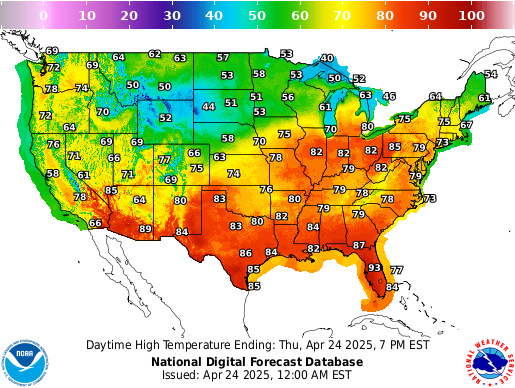
National Temperature
Alaska | Hawaii | Guam | Puerto Rico/Virgin Islands More from the National Digital Forecast Database
Short Range Forecasts
Short range forecast products depicting pressure patterns, circulation centers and fronts, and types and extent of precipitation.
12 Hour | 24 Hour | 36 Hour | 48 Hour
Medium Range Forecasts
Medium range forecast products depicting pressure patterns and circulation centers and fronts
Day 3 | Day 4 | Day 5 | Day 6
Precipitation Amounts
Quantitative precipitation forecasts.
Day 1 | Day 2 | Day 3
Surface Analysis
Highs, lows, fronts, troughs, outflow boundaries, squall lines, drylines for much of North America, the Western Atlantic and Eastern Pacific oceans, and the Gulf of Mexico.
Standard Size | High Resolution

Temperature
Maximum daytime or minimum overnight temperature in degrees Fahrenheit.
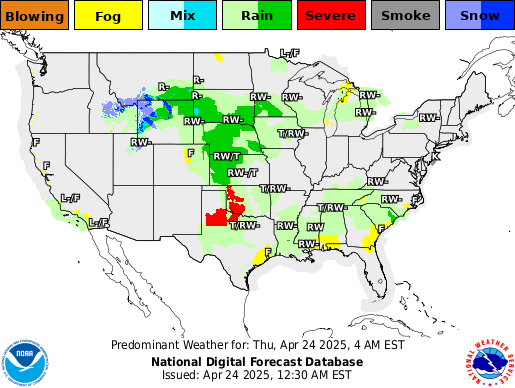
Predominant Weather
Expected weather (precipitating or non-precipitating) valid at the indicated hour. The weather element includes type, probability, and intensity information.

Wind Speed and Direction
Sustained wind speed (in knots) and expected wind direction (using 36 points of a compass) forecasts.
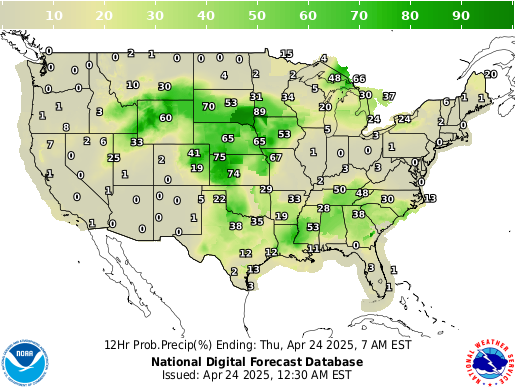
Chance of Precipitation
Likelihood, expressed as a percent, of a measurable precipitation event (1/100th of an inch).
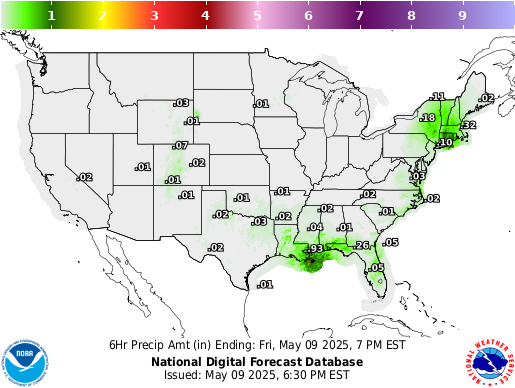
Precipitation Amount
Total amount of expected liquid precipitation.

Expected amount of opaque clouds (in percent) covering the sky.
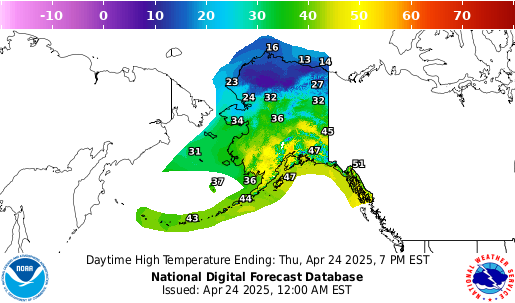
Alaska Graphical Forecasts
Graphical forecasts from the National Digital Forecast Database for Alaska.

Hawaii Graphical Forecasts
Graphical forecasts from the National Digital Forecast Database for Hawaii.
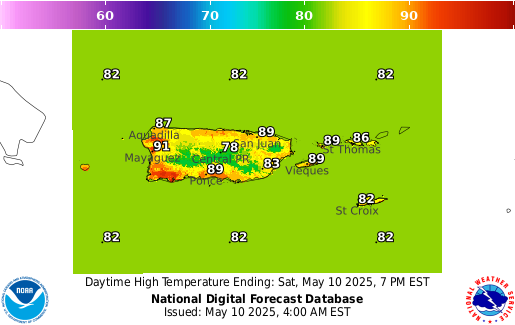
Puerto Rico Graphical Forecasts
Graphical forecasts from the National Digital Forecast Database for Puerto Rico and Virgin Islands.
ACTIVE ALERTS Warnings By State Excessive Rainfall and Winter Weather Forecasts River Flooding Latest Warnings Thunderstorm/Tornado Outlook Hurricanes Fire Weather Outlooks UV Alerts Drought Space Weather NOAA Weather Radio NWS CAP Feeds
PAST WEATHER Climate Monitoring Past Weather Monthly Temps Records Astronomical Data Certified Weather Data
CURRENT CONDITIONS Radar Climate Monitoring River Levels Observed Precipitation Surface Weather Upper Air Marine and Buoy Reports Snow Cover Satellite Space Weather International Observations
FORECAST Local Forecast International Forecasts Severe Weather Current Outlook Maps Drought Fire Weather Fronts/Precipitation Maps Current Graphical Forecast Maps Rivers Marine Offshore and High Seas Hurricanes Aviation Weather Climatic Outlook
INFORMATION CENTER Space Weather Daily Briefing Marine Climate Fire Weather Aviation Forecast Models Water GIS Cooperative Observers Storm Spotters Tsunami Warning System National Water Center International Weather
WEATHER SAFETY NOAA Weather Radio StormReady Heat Lightning Hurricanes Thunderstorms Tornadoes Rip Currents Floods Tsunamis TsunamiReady Winter Weather Ultra Violet Radiation Air Quality Damage/Fatality/Injury Statistics Red Cross Federal Emergency Management Agency (FEMA) Brochures Safe Boating
NEWS Newsroom Events Pubs/Brochures/Booklets
EDUCATION NWS Education Home Be A Force of Nature NOAA Education Resources Glossary JetStream NWS Training Portal NOAA Library For Students, Parents and Teachers Brochures
ABOUT Organization NWS Transformation Strategic Plan For NWS Employees International National Centers Products and Services Careers Glossary Contact Us Social Media
US Dept of Commerce National Oceanic and Atmospheric Administration National Weather Service 1325 East West Highway Silver Spring, MD 20910 Comments? Questions? Please Contact Us.
Security Alert May 17, 2024
Worldwide caution, update may 10, 2024, information for u.s. citizens in the middle east.
- Travel Advisories |
- Contact Us |
- MyTravelGov |
Find U.S. Embassies & Consulates
Travel.state.gov, congressional liaison, special issuance agency, u.s. passports, international travel, intercountry adoption, international parental child abduction, records and authentications, popular links, travel advisories, mytravelgov, stay connected, legal resources, legal information, info for u.s. law enforcement, replace or certify documents.
Share this page:
Russia Travel Advisory
Travel advisory september 5, 2023, russia - level 4: do not travel.
Updated to remove COVID-specific information and the kidnapping risk indicator as well as updates to security risks.
Do not travel to Russia due to the unpredictable consequences of the unprovoked full-scale invasion of Ukraine by Russian military forces , the potential for harassment and the singling out of U.S. citizens for detention by Russian government security officials , the arbitrary enforcement of local law , limited flights into and out of Russia , the Embassy’s limited ability to assist U.S. citizens in Russia , and the possibility of terrorism . U.S. citizens residing or travelling in Russia should depart immediately. Exercise increased caution due to the risk of wrongful detentions.
The U.S. government’s ability to provide routine or emergency services to U.S. citizens in Russia is severely limited, particularly in areas far from the U.S. Embassy in Moscow, due to Russian government limitations on travel for embassy personnel and staffing, and the ongoing suspension of operations, including consular services, at U.S. consulates.
There have been numerous reports of drone attacks, explosions, and fires in areas in Western and Southern Russia, particularly near the Russian border with Ukraine, as well as in Moscow and St. Petersburg. In the event of an emergency, U.S. citizens should follow instructions from local authorities and seek shelter immediately.
In September 2022, the Russian government mobilized citizens to the armed forces in support of its invasion of Ukraine. Russia may refuse to acknowledge dual nationals’ U.S. citizenship, deny their access to U.S. consular assistance, subject them to mobilization, prevent their departure from Russia, and/or conscript them.
U.S. citizens should note that U.S. credit and debit cards no longer work in Russia, and options to electronically transfer funds from the United States are extremely limited due to sanctions imposed on Russian banks. There are reports of cash shortages within Russia.
Commercial flight options are extremely limited and are often unavailable on short notice. If you wish to depart Russia, you should make independent arrangements as soon as possible. The U.S. Embassy has severe limitations on its ability to assist U.S. citizens to depart the country and transportation options may suddenly become even more limited. Click here for Information for U.S. Citizens Seeking to Depart Russia.
U.S. Embassy personnel are generally not permitted to travel on Russian air carriers due to safety concerns. The Federal Aviation Administration (FAA) downgraded the air safety rating for Russia from Category 1 to Category 2 on April 21, 2022, due to Russia’s Federal Agency for Air Transport noncompliance with International Civil Aviation Organization (ICAO) safety standards. The Federal Aviation Administration (FAA) has issued a Notice to Air Missions (NOTAM) prohibiting U.S. aviation operations into, out of, within, or over those areas of the Moscow Flight Information Region (FIR), the Samara FIR (UWWW) and the Rostov-na-Donu (URRV) FIR within 160NM of the boundaries of the Dnipro (UKDV) Flight Information Regions. For more information, U.S. citizens should consult the Federal Aviation Administration’s Prohibitions, Restrictions, and Notices .
The right of peaceful assembly and freedom of expression are not consistently protected in Russia. U.S. citizens should avoid all political or social protests and not photograph security personnel at these events. Russian authorities have arrested U.S. citizens who have participated in demonstrations and there are numerous reports Russian nationals have been detained for social media activity.
Country Summary:
U.S. citizens, including former and current U.S. government and military personnel and private citizens engaged in business who are visiting or residing in Russia, have been interrogated without cause and threatened by Russian officials, and may become victims of harassment, mistreatment, and extortion.
Russian security services may fail to notify the U.S. Embassy of the detention of a U.S. citizen and unreasonably delay U.S. consular assistance. Russian security services are increasing the arbitrary enforcement of local laws to target foreign and international organizations they consider “undesirable.”
Russian security services have arrested U.S. citizens on spurious charges, singled out U.S. citizens in Russia for detention and harassment, denied them fair and transparent treatment, and convicted them in secret trials or without presenting credible evidence. Furthermore, Russian authorities arbitrarily enforce local laws against U.S. citizen religious workers and have opened questionable criminal investigations against U.S. citizens engaged in religious activity. U.S. citizens should avoid travel to Russia to perform work for or volunteer with non-governmental organizations or religious organizations.
There have been multiple security incidents in southwestern Russia related to Russia’s unprovoked and unjustified invasion of Ukraine. The Russian government declared martial law in Russia’s regions bordering Ukraine (Bryansk, Kursk, Belgorod, Voronezh, Rostov, Krasnodar) on October 20, 2022. The martial law regime allows the rapid introduction of restrictive measures such as curfew, seizure of private property, restriction of entry/exit and freedom of movement, internment of foreigners, forced relocation of local residents, and restrictions on public gatherings. U.S. citizens should avoid all travel to these areas.
Recent legislation has expanded the ability of Russian authorities to detain, question, and arrest individuals suspected of acting against Russia’s interests, including posts on personal social media accounts, engaging with foreign and international entities, discrediting the Russian state or military, as well as advocating for the rights of LGBTQI+ persons.
Terrorist groups, both transnational and local terrorist organizations, and individuals inspired by extremist ideology continue plotting possible attacks in Russia. Terrorists may attack with little or no warning, targeting tourist locations, transportation hubs and systems, markets/shopping malls, local government facilities, hotels, clubs, restaurants, places of worship, parks, major sporting and cultural events, educational institutions, airports, and other public areas. Travel to the North Caucasus (including Chechnya and Mt. Elbrus) is prohibited for U.S. government employees and strongly discouraged for U.S. citizens.
The international community, including the United States and Ukraine, does not recognize Russia’s purported annexation of Crimea as well as four other Ukrainian oblasts – Donetsk, Luhansk, Kherson, and Zaporizhzhya – that Russia has purported to annex more recently. There is extensive Russian Federation military presence in these areas. Russia staged its further invasion of Ukraine, in part, from occupied Crimea, and Russia is likely to take further military actions in Crimea, and the four other Ukrainian oblasts are the subject of intensive fighting. There are continuing abuses against foreigners and the local population by the occupation authorities in these regions, particularly against those who are seen as challenging Russia’s authority.
The U.S. Embassy in Kyiv continues to provide consular services to U.S. citizens in Crimea as well as four other Ukrainian oblasts partially occupied by Russia – Donetsk, Luhansk, Kherson, and Zaporizhzhya, although the ongoing conflict severely restricts the Embassy’s ability to provide services in these areas.
Read the country information page for additional information on travel to Russia.
If you decide to travel to Russia:
- Familiarize yourself with the information on what the U.S. government can and cannot do to assist you in a crisis overseas .
- Have a contingency plan in place that does not rely on U.S. government assistance. Review the Traveler’s Checklist .
- Monitor local and international media for breaking events and adjust your contingency plans based on the new information.
- Ensure travel documents are valid and easily accessible.
- Visit our website for Travel to High-Risk Areas .
- Enroll in the Smart Traveler Enrollment Program (STEP) to receive Alerts and make it easier to locate you in an emergency.
- Follow the Department of State on Facebook and Twitter .
- Review the Country Security Report for Russia.
- Visit the CDC page for the latest Travel Health Information related to your travel.
Travel Advisory Levels
Assistance for u.s. citizens, russian federation map, search for travel advisories, external link.
You are about to leave travel.state.gov for an external website that is not maintained by the U.S. Department of State.
Links to external websites are provided as a convenience and should not be construed as an endorsement by the U.S. Department of State of the views or products contained therein. If you wish to remain on travel.state.gov, click the "cancel" message.
You are about to visit:
AAA Newsroom
Automotive, Travel, and Traffic Safety Information
Nearly 44 Million Travelers Leaving Town for Unofficial Start of Summer
Second highest memorial day holiday travel forecast since aaa began tracking in 2000.

WASHINGTON, DC (May 13, 2024) – AAA projects 43.8 million travelers will head 50 miles or more from home over the Memorial Day holiday travel period*. This year’s total number of travelers is a 4% increase over last year and comes close to matching 2005’s record of 44 million Memorial Day travelers.
“We haven’t seen Memorial Day weekend travel numbers like these in almost 20 years,” said Paula Twidale, Senior Vice President of AAA Travel. “We’re projecting an additional one million travelers this holiday weekend compared to 2019, which not only means we’re exceeding pre-pandemic levels but also signals a very busy summer travel season ahead.”
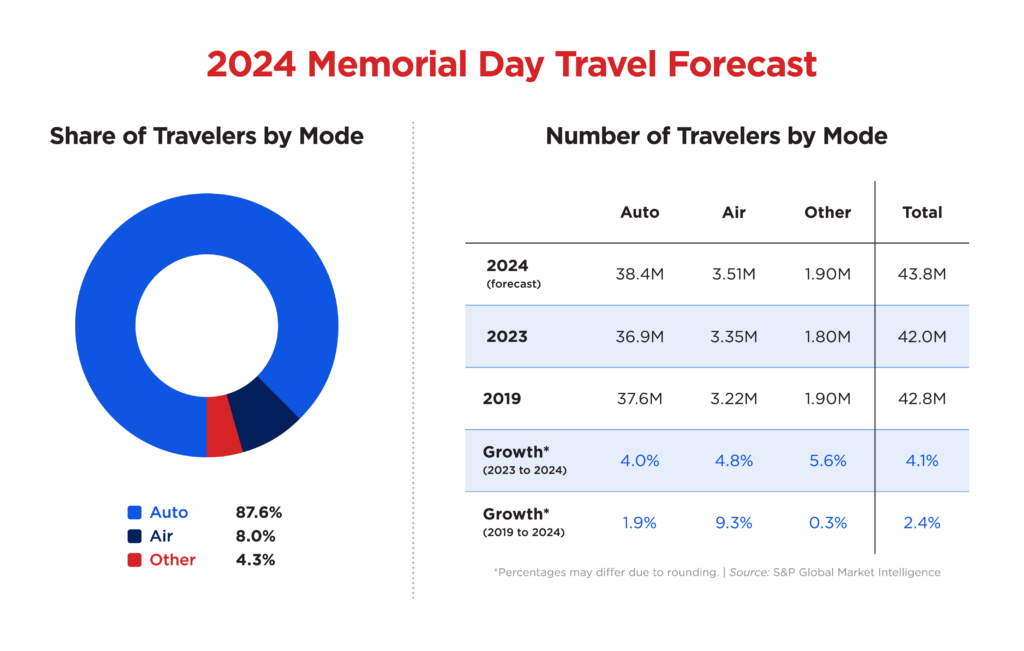
Road trips are expected to set a record. AAA projects 38.4 million people will travel by car over Memorial Day weekend, the highest number for that holiday since AAA began tracking in 2000. The number of drivers this year is up 4% compared to last year and 1.9% higher than in 2019. Traveling by car is appealing for many people because of the convenience and flexibility it provides. AAA car rental partner Hertz says Orlando, Denver, Atlanta, Boston and Las Vegas are the cities displaying the highest rental demand , with the busiest pick-up days projected to be Thursday, May 23 and Friday, May 24.
This Memorial Day weekend drivers can expect similar gas prices as last year when the national average was roughly $3.57. Pump prices rose this spring but have held somewhat steady in recent weeks. Prices may creep higher as the summer driving season gets underway. The wildcard remains the cost of oil, and unlike last year, there are now two wars – in the Middle East and Ukraine – that could roil the oil market.
Airports are bracing for a spike in travelers. AAA expects 3.51 million air travelers this holiday weekend, an increase of 4.8% over last year and 9% jump compared to 2019. This will be the most crowded Memorial Day weekend at airports since 2005, when 3.64 million flew for the holiday as the travel industry finally rebounded post 9/11. This Memorial Day weekend, air ticket prices are comparable to last year. AAA booking data shows a 1% to 2% increase in prices for domestic flights. Several factors play into how much travelers pay for airfare, including destination, number of stops, and fare class. For example, passengers who book nonstop flights with seat selection and carry-on bags included will likely pay more than those who select basic economy with a layover.
Nearly two million people are expected to travel by other modes of transportation, including buses, cruises, and trains. AAA projects 1.9 million people will take these other modes of transportation, an increase of 5.6% compared to last year. “This category took the biggest hit during the pandemic with fewer people taking public transportation or not cruising at all,” Twidale said. “Now – five years later – we’re back to 2019 numbers. Travel demand has been soaring, and long holiday weekends create the perfect windows for getaways.”
Best/Worst Times to Drive and Peak Congestion by Metro
INRIX , a provider of transportation data and insights, says drivers leaving Thursday or Friday should hit the road early to avoid mixing with commuters. Travelers going back home on Sunday or Monday should avoid the afternoon hours when return trips will peak.
“Travel times are expected to be up to 90% longer than normal. Travelers should stay up to date on traffic apps, 511 services, and local news stations to avoid sitting in traffic longer than necessary,” said Bob Pishue, transportation analyst at INRIX.
Please note that the times listed below are for the time zone in which the metro is located.
For example, Atlanta routes = ET and Los Angeles routes = PT
Source: INRIX
Source: INRIX
Top Destinations
This Memorial Day weekend, travelers are seeking theme parks and entertainment venues in Orlando, New York, Las Vegas, and Southern California. Seattle, Anchorage, and Vancouver rank high because of the popularity of Alaska cruises this time of year. Florida beaches and cruise ports will also be packed. European cities dominate the international list. The top 10 domestic and international destinations below are based on AAA booking data.
Travel Trends
As travelers make plans for summer and beyond, AAA Travel has identified the following trends:
- Bucket Lists : Travelers taking once-in-a-lifetime trips
- Milestones : Families booking anniversary, retirement, and family reunion trips
- Asia : More travelers interested in visiting Asia, especially Japan
- Solo Trips : More people, especially women, interested in traveling by themselves
- Luxury Vacations : More travelers seeking high-end cruises and tours
- Trains : Many travelers interested in rail vacations across New England, Canada, and Europe
- Adventure in Nature : Travelers booking trips to Antarctica, Africa, and South Pacific
Travel Agent Survey
A recent survey of AAA travel agents highlights topics travelers are frequently discussing when booking trips:
- Travel Insurance : 51 % of agents say more travelers are interested in protecting their trips
- 77% of agents say ocean cruises
- 70% of agents say all-inclusive vacations
- 67% of agents say river cruises
Holiday Travel Forecast Methodology
In cooperation with AAA, S&P Global Market Intelligence (SPGMI) developed a unique methodology to forecast actual domestic travel volumes. The economic variables used to forecast travel for the current holiday are leveraged from SPGMI’s proprietary databases. These data include macroeconomic drivers such as employment, output, household net worth, asset prices, including stock indices, interest rates, housing market indicators, and variables related to travel and tourism, including gasoline prices, airline travel, and hotel stays. AAA and SPGMI have quantified holiday travel volumes going back to 2000.
Historical travel volume estimates come from DK SHIFFLET’s TRAVEL PERFORMANCE/Monitor SM . The PERFORMANCE/Monitor SM is a comprehensive study measuring the travel behavior of U.S. residents. DK SHIFFLET contacts over 50,000 U.S. households each month to obtain detailed travel data, resulting in the unique ability to estimate visitor volume and spending, identify trends, and forecast U.S. travel behavior, all after the trips have been taken.
The travel forecast is reported in person-trips. In particular, AAA and SPGMI forecast the total U.S. holiday travel volume and expected mode of transportation. The travel forecast presented in this report was prepared the week of April 15, 2024.
*Memorial Day Holiday Travel Period
For this forecast, the Memorial Day holiday travel period is defined as the five-day period from Thursday, May 23 to Monday, May 27, 2024.
AAA Travel Agent Survey Methodology
AAA clubs distributed surveys to a random sample of their travel agents between March 18 and March 29, 2024 to understand recent traveler trends over the past 60 days. 186 AAA agent responses were collected from 13 AAA clubs (representing 97% of AAA membership overall as of February 2024).
About AAA
Started in 1902 by automotive enthusiasts who wanted to chart a path for better roads in America and advocate for safe mobility, AAA has transformed into one of North America’s largest membership organizations. Today, AAA provides roadside assistance, travel, discounts, financial and insurance services to enhance the life journey of 64 million members across North America, including 57 million in the United States. To learn more about all AAA has to offer or to become a member, visit AAA.com.
About S&P Global S&P Global (NYSE: SPGI) provides essential intelligence. We enable governments, businesses, and individuals with the right data, expertise, and connected technology so that they can make decisions with conviction. From helping our customers assess new investments to guiding them through ESG and energy transition across supply chains, we unlock new opportunities, solve challenges, and accelerate progress for the world. We are widely sought after by many of the world’s leading organizations to provide credit ratings, benchmarks, analytics, and workflow solutions in the global capital, commodity, and automotive markets. With every one of our offerings, we help the world’s leading organizations plan for tomorrow today. For more information, visit www.spglobal.com .
About DKSA
DK SHIFFLET boasts the industry’s most complete database on U.S. resident travel both in the U.S. and worldwide. Data is collected monthly from a U.S. representative sample, adding over 60,000 traveling households annually, and is used daily by leading travel organizations and their strategic planning groups. DK SHIFFLET is an MMGY Global company.
About INRIX
Founded in 2004, INRIX pioneered intelligent mobility solutions by transforming big data from connected devices and vehicles into mobility insights. This revolutionary approach enabled INRIX to become one of the leading providers of data and analytics into how people move. By empowering cities, businesses, and people with valuable insights, INRIX is helping to make the world smarter, safer, and greener. With partners and solutions spanning across the entire mobility ecosystem, INRIX is uniquely positioned at the intersection of technology and transportation – whether it’s keeping road users safe, improving traffic signal timing to reduce delay and greenhouse gasses, optimizing last mile delivery, or helping uncover market insights. Learn more at INRIX.com.
US airlines forecast record 2024 summer travel, up 6.3% over last year
- Medium Text

Sign up here.
Reporting by David Shepardson; editing by Jonathan Oatis and Michael Erman
Our Standards: The Thomson Reuters Trust Principles. New Tab , opens new tab

Business Chevron

US regulators reconsider capital hike for big banks, WSJ reports
The Federal Reserve and two other U.S. regulators are moving toward a new plan that would significantly reduce a nearly 20% mandated increase in capital for the country's biggest banks following lobbying efforts by industry CEOs like JPMorgan Chase's Jamie Dimon, the Wall Street Journal reported on Sunday.
European private equity group EQT is in advanced discussions to buy Dublin-based video game services company Keywords Studios for 2.2 billion pounds ($2.79 billion), the companies said in a statement.


An official website of the United States government
Here’s how you know
Official websites use .gov A .gov website belongs to an official government organization in the United States.
Secure .gov websites use HTTPS A lock ( Lock A locked padlock ) or https:// means you’ve safely connected to the .gov website. Share sensitive information only on official, secure websites.
Strong geomagnetic storm reaches Earth, continues through weekend
NOAA space weather forecasters have observed at least seven coronal mass ejections (CMEs) from the sun, with impacts expected to arrive on Earth as early as midday Friday, May 10, and persist through Sunday, May 12, 2024.
NOAA’s Space Weather Prediction Center (SWPC) has issued a Geomagnetic Storm Warning for Friday, May 10. Additional solar eruptions could cause geomagnetic storm conditions to persist through the weekend.
- The First of Several CMEs reached Earth on Friday, May 10 at 12:37 pm EDT. The CME was very strong and SWPC quickly issued a series of geomagnetic storm warnings. SWPC observed G4 conditions at 1:39 pm EDT (G3 at 1:08 pm EDT).
- This storm is ongoing and SWPC will continue to monitor the situation and provide additional warnings as necessary.
This is an unusual and potentially historic event. Clinton Wallace , Director, NOAA’s Space Weather Prediction Center
CMEs are explosions of plasma and magnetic fields from the sun’s corona. They cause geomagnetic storms when they are directed at Earth. Geomagnetic storms can impact infrastructure in near-Earth orbit and on Earth’s surface , potentially disrupting communications, the electric power grid, navigation, radio and satellite operations. SWPC has notified the operators of these systems so they can take protective action.
Geomagnetic storms can also trigger spectacular displays of aurora on Earth . A severe geomagnetic storm includes the potential for aurora to be seen as far south as Alabama and Northern California.
Related Features //
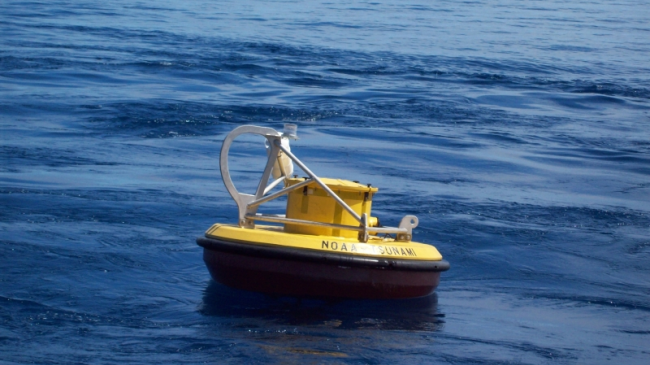

An official website of the United States government
Here’s how you know

Official websites use .gov A .gov website belongs to an official government organization in the United States.
Secure .gov websites use HTTPS A lock ( Lock A locked padlock ) or https:// means you’ve safely connected to the .gov website. Share sensitive information only on official, secure websites.

- National Media Release
CBP Releases April 2024 Monthly Update
WASHINGTON — U.S. Customs and Border Protection (CBP) released operational statistics today for April 2024. CBP monthly reporting can be viewed on CBP’s Stats and Summaries webpage .
“CBP continues to surge resources and personnel to impacted sectors along the border to ensure the safe, swift, and orderly processing of individuals to maximize expedited removals. We have redoubled our efforts, in coordination with partners throughout the hemisphere and around the world, to disrupt the criminal organizations and transportation networks who are putting vulnerable migrants in danger while peddling lies and profiting from them. We have executed the largest surge of removals and disruptive activities against human smuggling networks in the past decade,” said Troy A. Miller, Senior Official Performing the Duties of the Commissioner . “As a result of this increased enforcement, southwest border encounters have not increased, bucking previous trends. We will remain vigilant to continually shifting migration patterns. We are still experiencing challenges along the borders and the nation’s immigration system is not appropriately resourced to handle them, so we continue to call on Congress to take action that would provide our personnel with additional resources and tools.”
CBP continues to work tirelessly to strengthen border security and enforcement efforts, including collaborating with U.S. Immigration and Customs Enforcement (ICE) and U.S. Citizenship and Immigration Services (USCIS) to quickly process noncitizens encountered at the border and remove or return those who do not establish a legal basis to remain in the United States, delivering strengthened consequences promulgated by the Circumvention of Lawful Pathways rule and its associated measures. Since the lifting of Title 42 May 12, 2023 to April 30, 2024, DHS has removed or returned over 720,000 individuals, the vast majority of whom crossed the southwest border, including more than 109,000 individual family members. Total removals and returns since mid-May 2023 exceed removals and returns in every full fiscal year since 2011.
Below are key operational statistics for CBP’s primary mission areas in April 2024. View all CBP statistics online
Ensuring Border Security and Managing Migration
CBP continues to expeditiously process, remove, and strengthen consequences for individuals who cross our borders unlawfully. Individuals and families without a legal basis to remain in the U.S. are subject to removal pursuant to Title 8 authorities and are subject to a minimum five-year bar on admission as well as potential prosecution if they subsequently re-enter without authorization. No one should believe the lies of smugglers. The fact is that people without a legal basis to remain in the United States will be removed.
The United States is working together with our domestic and foreign partners to jointly disrupt irregular migration across the region, offering safe, orderly, and lawful pathways for intending migrants and taking action against ruthless smugglers who continue to spread falsehoods and show disregard for the safety and well-being of vulnerable migrants.
In April 2024, the U.S. Border Patrol recorded 128,900 encounters between ports of entry along the southwest border. In April, encounters between ports of entry along the southwest border were 6% lower than in March 2024 and 30% lower than April 2023.
CBP continually analyzes and responds to changes in migration patterns, particularly irregular migration outside of lawful pathways and border crossings. We work with our federal and international partners to combat human smuggling. The fact remains: the United States continues to enforce immigration law, and those without a legal basis to remain will be removed. Migrants attempting to enter without authorization are subject to removal under Title 8 authorities.
The U.S. Border Patrol has undertaken significant efforts in recent years to expand capacity to aid and rescue individuals in distress. To prevent the loss of life, CBP initiated a Missing Migrant Program in 2017 that locates noncitizens reported missing, rescues individuals in distress, and reunifies decedents’ remains with their families in the border region. In April, the U.S. Border Patrol conducted 411 rescues, bringing the FY 2024 total to 3,096 rescues.
View more migration statistics and rescues statistics .
CBP One™ App
The CBP One™ mobile application remains a key scheduling tool as part of DHS’s efforts to incentivize noncitizens to use lawful, safe, humane, and orderly pathways and processes. Generally, noncitizens who cross between the ports of entry or who present themselves at a port of entry without making a CBP One™ appointment are subject to the Circumvention of Lawful Pathways rule. This rule presumes asylum ineligibility for those who fail to use lawful processes, with certain exceptions. DHS encourages migrants to utilize lawful processes, rather than taking the dangerous journey to cross unlawfully between the ports of entry, which also carries consequences under Title 8.
The CBP One™ app allows noncitizens throughout central or northern Mexico who lack documents sufficient for admission to the United States to schedule an appointment and remain in place until presenting at a preferred port of entry for their appointment, reducing migrants’ need to crowd into immediate border areas. Use of the CBP One™ app to schedule appointments at ports of entry has increased CBP’s capacity to process migrants more efficiently and orderly while cutting out unscrupulous smugglers who endanger and profit from vulnerable migrants.
In April, CBP processed 41,400 individuals through appointments at ports of entry utilizing advanced information submitted in CBP One™. Since the appointment scheduling function in CBP One™ was introduced in January 2023 through the end of April 2024, more than 591,000 individuals have successfully scheduled appointments to present at ports of entry instead of risking their lives in the hands of smugglers. The top nationalities processed subsequent to arrival for their appointment are Cuban, Haitian, Honduran, Mexican, and Venezuelan.
A percentage of daily available appointments are allocated to the earliest registered CBP One™ profiles, so noncitizens who have been trying to obtain appointments for the longest time are prioritized. CBP is continually monitoring and evaluating the application to ensure its functionality and guard against bad actors.
CHNV Parole Processes
On January 5, 2023, DHS announced processes providing certain Cubans, Haitians, and Nicaraguans who have a supporter in the United States undergo and clear robust security vetting and meet other eligibility criteria authorization to travel to the United States in a safe, orderly, and lawful way. Once they purchase commercial airline tickets for themselves These processes were built on the success of the process for Venezuelans established in October 2022; they are publicly available online, and DHS has been providing regular updates on their use to the public. This is part of the Administration’s strategy to combine expanded lawful pathways with stronger consequences to reduce irregular migration and have kept hundreds of thousands of people from migrating irregularly.Through the end of April 2024, 434,800 Cubans, Haitians, Nicaraguans, and Venezuelans arrived lawfully on commercial flights and were granted parole under these processes. Specifically, 95,500 Cubans, 184,600 Haitians, 83,800 Nicaraguans, and 109,200 Venezuelans were vetted and authorized for travel; and 91,100 Cubans, 166,700 Haitians, 75,700 Nicaraguans, and 101,200 Venezuelans arrived lawfully and were granted parole.
Safeguarding Communities by Interdicting Narcotics and Dangerous Drugs
As the largest law enforcement agency in the United States, CBP is uniquely positioned to detect, identify, and seize illicit drugs before they enter our communities. CBP’s combination of interdiction and intelligence capabilities, complemented by its border search authorities, scientific services, non-intrusive inspection equipment, and canine detection teams, places it at the forefront of the U.S. government’s efforts to combat illicit fentanyl and other dangerous drugs.
In April, CBP also announced an expanded, multi-agency effort to target transnational criminals funneling fentanyl from Mexico into American communities. Operation Plaza Spike targets the cartels that facilitate the flow of deadly fentanyl, as well as its analogs, precursors, and tools to make the drugs. The operation is designed to disrupt operations in the “plazas,” cartel territories located directly south of the United States that are natural logistical chokepoints within the cartels’ operations. This is the next phase in CBP’s Strategy to Combat Fentanyl and Other Synthetic Drugs, a whole-of-government and international effort to anticipate, identify, mitigate, and disrupt illicit synthetic drug producers, suppliers, and traffickers.
That strategy also includes conducting operations, including Operation Apollo, that target the smuggling of illicit fentanyl and other dangerous drugs. First implemented in southern California in October 2023, and recently expanded into Arizona, Operation Apollo utilizes local field assets augmented by federal, state, local, tribal, and territorial partners to target drug traffickers’ supply chains in select locations based on ongoing investigations, intelligence collection, and drug seizure data. Operation Apollo targets items required in the production of illicit fentanyl, including precursor chemicals, pill presses and parts, movement of finished product, and illicit proceeds.
Nationwide in April, cocaine seizures increased by 95% compared to March. To date in FY 2024 through the end of April, CBP has seized over 11,400 pounds of fentanyl. CBP has caught more fentanyl nationwide between the start of fiscal year 2023 through April 30, 2024 than in the previous five fiscal years combined, and we continue to optimize our intelligence and field operations to stop these deadly substances from reaching American communities.
Additional CBP drug seizure statistics can be found on the Drug Seizure Statistics webpage .
Facilitating Lawful Trade and Travel
As international travel continues to increase, CBP is leveraging technology to streamline efficiency and increase security at air and land ports of entry. Travelers are encouraged to utilize CBP’s mobile apps to enhance their travel experience, including the Global Entry Mobile Application and Mobile Passport Control , as well as new Global Entry Touchless Portals at nearly all international airports across the United States, which protect passenger privacy and expedite arrival processing by eliminating paper receipts.
Commercial trucks processed at ports of entry increased 15% from April 2023 to April 2024. Travelers arriving by air into the United States increased 8% in the same period; passenger vehicles processed at ports of entry increased 3% ; and pedestrians arriving by land at ports of entry increased 2% over the same period.
CBP works diligently with the trade community and port operators to ensure that merchandise is cleared as efficiently as possible and to strengthen international supply chains and improve border security. In April 2024, CBP processed more than 3.2 million entry summaries valued at more than $289 billion, identifying estimated duties of nearly $6.4 billion to be collected by the U.S. government. In April, trade via the ocean environment accounted for 39.66% of the total import value, followed by air, truck, and rail.
View more travel statistics , and trade statistics .
Protecting Consumers, Eradicating Forced Labor from Supply Chains, and Promoting Economic Security
CBP continues to lead U.S. government efforts to eliminate goods from the supply chain made with forced labor from the Xinjiang Uyghur Autonomous Region of China. In April, CBP stopped 392 shipments valued at more than $184 million for further examination based on the suspected use of forced labor.
Intellectual property rights violations continue to put America’s innovation economy at risk. Counterfeit and pirated goods threaten the competitiveness of U.S. businesses, the livelihoods of American workers, and the health and safety of consumers.
Consumers are encouraged to be alert to the dangers of counterfeit goods especially when shopping online as they support criminal activity, hurt American businesses, and often have materials or ingredients that can pose serious health and safety risks. Every year CBP seizes millions of counterfeit products worth billions of dollars had they been genuine. In April, CBP seized 1,736 shipments that contained counterfeit goods valued at more than $235 million . More information about CBP’s intellectual property rights enforcement is available at https://www.cbp.gov/trade .
CBP completed 20 audits in April that identified $13 million in duties and fees owed to the U.S. government, stemming from goods that had been improperly declared in accordance with U.S. trade laws and customs regulations. CBP collected over $5.7 million of this identified revenue and from previous fiscal years’ assignments.
CBP is on the frontline of textiles and trade agreements enforcement, combating textile imports that are not compliant with U.S. trade laws. Protecting the domestic textile industry and American consumers is vital to U.S. national security, health care, and economic priorities. Toward this end, CBP is intensifying its targeting and enforcement efforts to increase and expedite the prosecution of illegal customs practices. CBP’s efforts include de minimis compliance, forced labor enforcement, cargo compliance, regulatory audits, and public awareness. This month DHS announced an enhanced strategy to combat illicit trade and level the playing field for the American textile industry, which accounts for over 500,000 U.S. jobs and is critical for our national security. The plan details the actions CBP and Homeland Security Investigations will take to hold perpetrators accountable for customs violations and safeguard the American textile industry.
View more UFLPA enforcement statistics , and intellectual property rights enforcement statistics.
Defending our Nation’s Agricultural System
Through targeting, detection, and interception, CBP agriculture specialists work to prevent threats from entering the United States.
CBP issued 7,139 emergency action notifications for restricted and prohibited plant and animal products entering the United States in April 2024. CBP conducted 101,416 positive passenger inspections and issued 823 civil penalties and/or violations to the traveling public for failing to declare prohibited agriculture items.
View more agricultural enforcement statistics .
U.S. Customs and Border Protection (CBP) is America's frontline: the nation's largest law enforcement organization and the world's first unified border management agency. The 65,000+ men and women of CBP protect America on the ground, in the air, and on the seas. We facilitate safe, lawful travel and trade and ensure our country's economic prosperity. We enhance the nation's security through innovation, intelligence, collaboration, and trust.
- Skip to main content
- Skip to secondary menu
- Skip to primary sidebar
SDTA Connect Blog
Keeping you connected to the San Diego Tourism Authority and the hospitality community.
FY24-SDTA-NTTW-Toolkit_2025-Forecast
May 17, 2024 By Brent Bernasconi Leave a Comment
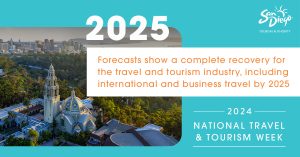
Reader Interactions
Leave a reply cancel reply.
Your email address will not be published. Required fields are marked *
Save my name, email, and website in this browser for the next time I comment.

AAA says 2024 to be second highest Memorial Day travel forecast since 2000
May 13 (UPI) -- The American Automobile Association, better known as AAA, on Monday released data which estimates nearly 44 million American travelers will leave town in what will be the second highest Memorial Day travel forecast since 2000 when data was first available.
"We haven't seen Memorial Day weekend travel numbers like these in almost 20 years," Paula Twidale, Senior Vice President of AAA Travel, said in a release.
AAA projects 43.8 million travelers will go 50 miles or more from home over the Memorial Day holiday travel period, which they said was a 4% increase from 2023 and comes close to matching the record of 44 million Memorial Day travelers in 2005.
"We're projecting an additional one million travelers this holiday weekend compared to 2019, which not only means we're exceeding pre-pandemic levels but also signals a very busy summer travel season ahead," the AAA executive added.
AAA expects 3.51 million air travelers this Memorial Day weekend, a 4.8% increase over last year and a 9% jump compared to 2019.
"This will be the most crowded Memorial Day weekend at airports since 2005," AAA advised travelers.
In addition, AAA said nearly two million people are expected to travel by other modes of transportation which includes buses, cruise ships and trains, a 5.6% increase compared to 2023.
AAA defines this year's Memorial Day holiday travel period as the five-day period from May 23 to Monday, May 27.
Last year, AAA said that it was also expecting an uptick in travel over the 2023 Memorial Day weekend, although at the time road trips were reported to have not bounced back to pre-pandemic levels despite a temporary slide in gas prices.
But road travelers are also being advised to plan travel times accordingly to avoid and lessen traffic congestion.
"Travel times are expected to be up to 90% longer than normal," said Bob Pishue, transportation analyst at INRIX, who likewise advised travelers to "stay up to date on traffic apps, 511 services, and local news stations to avoid sitting in traffic longer than necessary."
AAA noted "the wildcard" remains the cost of oil because, unlike last year, there are now additional world military conflicts that could roil and impact the oil market.
In 2023, AAA projected 42.3 million Americans would travel 50 miles or more to a destination which was up 2.7 million people -- or 7% -- from 2022 the year prior.
But the price of gas this Memorial Day, however, is expected to be similar to last year when the national average was roughly $3.57, according to AAA.
"Pump prices rose this spring but have held somewhat steady in recent weeks," AAA said. "Prices may creep higher as the summer driving season gets underway."
But travel insiders have predicted that in 2024 people will plan more solo adventure trips, travel to Europe more and try out new things like 3D printed food.
This comes as the U.S. Customs and Border Protection said in early April that it will increase travel fees for some of the most well-known Trusted Travel Programs.
A recent American Express Travel report found that travelers are more focused on creating the right itineraries for their vacations, leaning towards sporting events, unusual adventures and solo travels that are taken on a whim.
However, the cost of traveling, including airfare and food costs is likely to keep rising with some companies focusing more on affordability as inflation is viewed as slowly getting under control.
The AAA travel statistics also come days after Illinois-based grocery chain Aldi announced that they have dropped the price of over 250 grocery items in stores nationwide to help customers fight "stubborn inflation" and better enjoy the summer.

- Faculty and Staff
- New Research
Reflecting on IALE and Presenting What’s Driving Residential Development Near Protected Areas

Editor’s note: Each semester, students in the Geospatial Analytics Ph.D. program can apply for a Geospatial Analytics Travel Award that supports research travel or presentations at conferences. The following is a guest post by travel award winner Eamon Espey as part of the Student Travel series .
Recently, the Center for Geospatial Analytics supported my attendance at the annual conference of the North American chapter of the International Association for Landscape Ecology (IALE) in Oklahoma City, Oklahoma. This conference was appreciably smaller than any I have previously presented at, but nonetheless, I was able to find familiar faces among the attendees. In addition to sharing the work I completed during my first year in the Geospatial Analytics Ph.D. program, I had the pleasure of supporting my fellow students at their presentations, meeting experts in the field and visiting a part of the country I had not been to before.
I presented on characterizing the factors driving residential development near national parks and other federally protected areas. My analysis included multiple random forest (RF) regression models to identify the importance of dozens of variables related to population characteristics, land use, natural amenities, the business environment and proximity to protected areas. These RF models were used to identify patterns in development for two decades (2000–2010 and 2010–2020) at both the national level as well as ten smaller regions. In general, population and housing density remained prominent factors across the country in both decades. However, natural features such as the abundance of bird and mammal species and proximity to protected areas gained significance in the second decade compared to the first, hinting at a growing preference for areas rich in natural resources.
The presentation was well received by other conference attendees and led to multiple quality discussions. I was thankful for how engaged the audience was, asking multiple good questions after I had finished. I am also thankful to have been introduced to this community, and I hope to continue fostering these professional connections.
In addition to attending and presenting at this conference, I took the opportunity to explore the city with my colleagues. We got to see a tulip festival, enjoy a wonderful steak dinner and play a round of disc golf. The conference was a valuable experience for me both professionally and personally. I was able to share my research, learn about others’ research and network with professionals in my field. I am grateful for the opportunity to have attended this conference and I look forward to attending future conferences.

- Geospatial Analytics Ph.D.
- Student Travel
More From Center for Geospatial Analytics
Exploring principles of open data and data sovereignty in landscape ecology, components to consider in choosing plant disease forecast models, a presentation at iale, a wonderful experience presenting at my first academic conference.

IMAGES
COMMENTS
What is the Travel Forecasting Resource ? This project came about due to a TRB research project designed to examine the state-of-the-practice in metropolitan travel forecasting. In the final report, Metropolitan Travel Forecasting: Current Practice and Future Direction, the committee identified many recommendations to improve travel demand ...
The Travel Forecasting Resource is an industry-vetted resource on the what and how of the art and science of travel forecasting. It is maintained by our Travel Forecasting Resource Subcommittee, which is chaired by Greg MacFarland and meets monthly. Community contributions and attendance at subcommittee meetings is welcome!
The Travel Forecasting Resource is an industry-vetted resource on the what and how of the art and science of travel forecasting. It is maintained by our Travel Forecasting Resource Subcommittee, which is chaired by Greg MacFarland and meets monthly. Community contributions and attendance at subcommittee meetings is welcome!
This website serves as a community resource for travel forecasting research and practice. We welcome your participation! This community is comprised of volunteers, many of whom are affiliated with the Transportation Research Board's Standing Committee (AEP50) on Transportation Demand Forecasting's Subcommittee for Travel Forecasting Resources.
This objective will be worked towards with the following outputs. Based on surveys and discussions at a workshop at the 2023 TRB Annual Meeting, the Committee is pursuing priorities in the following six areas: AEP50 is continuing efforts to prioritize and draft research needs statements, based on these areas.
What -- your resource type isn't in this list?!? Please click on the 'Talk' button above and leave a note for the Administrators and TF Resource Volunteers so additional resource types can be added to the list of options. Thank you for your interest in the Travel Forecasting Resource!
TFGuide provides resources and recommendations for evaluating travel forecasting methods that are prioritized based on how well they meet the user-defined planning needs and constraints. Note that the timeline and cost estimates used in TFGuide only include analysis work, and some plans and projects may require costs for non-analytical work.
that the practice of travel forecasting is ever evolving, allowing an administrator to update much of the content through its user interface rather than requiring programming. NCHRP Project 20-44(32) - through four multiagency workshops, peer exchange, and direct outreach - ... The method and resource categories used in the Current Methods ...
Technology Transfer Subcommittee Chair: Manage the subcommittee on technology transfer, including the Travel Forecasting Resource - Greg MacFarlane (needed: incoming chair) ... (TMIP) maintains a form/listserv which has served as the hearth of the travel forecasting community for decades. Young Member Communities. TRB Data, Planning, ...
The National Cooperative Highway Research Program and the Transportation Research Board (TRB) Travel Forecasting Resource are developing broad spectrum resources for travel forecasting and analysis. Feedback from lead modeling agencies during peer reviews requested additional context information to efficiently fit the modeling tool to fit ...
This project came about due to a TRB research project designed to examine the state-of-the-practice in metropolitan travel forecasting. In the final report, Metropolitan Travel Forecasting: Current Practice and Future Direction, the committee identified many recommendations to improve travel demand forecasting, including a national travel forecasting handbook to be developed and kept current.
Many regional travel forecasting models are designed to provide the best possible estimates of traffic volumes, but these models may not have been validated for speeds or travel times. ... # Tool Requirements and Technical Resources. Tools for project-level forecasts are selected mainly on the basis of the technical resources that might be ...
The Travel Forecasting Resources subcommittee of the Travel Demand Forecasting Committee of the Transportation Research Board - Travel Forecasting Resources
Travel Forecasting Resource tfresource.org . A wiki resource open to all members of the Travel Forecasting industry o Content contributed by the community, attributed to the contributor, * and member managed. uesong ou Fisher . With transparent direction open wiki discussions
Knowing what to expect during busier than usual travel times can save time and stress. From tracking the status of your airport to showing you how to pack safely, the FAA has a host of resources to help travelers plan ahead. Remember, the FAA has a zero-tolerance policy against unruly airline passengers in the wake of recent, troubling incidents.
Short Range Forecasts. Short range forecast products depicting pressure patterns, circulation centers and fronts, and types and extent of precipitation. 12 Hour | 24 Hour | 36 Hour | 48 Hour.
Travel Advisory. September 5, 2023. Russia - Level 4: Do Not Travel. O D U T. Updated to remove COVID-specific information and the kidnapping risk indicator as well as updates to security risks. Do not travel to Russia due to the unpredictable consequences of the unprovoked full-scale invasion of Ukraine by Russian military forces, the ...
5/13/2024. WASHINGTON, DC (May 13, 2024) - AAA projects 43.8 million travelers will head 50 miles or more from home over the Memorial Day holiday travel period*. This year's total number of travelers is a 4% increase over last year and comes close to matching 2005's record of 44 million Memorial Day travelers.
United Airlines (UAL.O) is forecasting a record-setting 3 million travelers expected to fly during the May 23-28 Memorial Day travel period, up nearly 10%. Delta Air Lines (DAL.N) said it expects ...
For the latest forecast please visit www.swpc.noaa.gov. May 10, 2024. RESOURCES. Audio file. Audio recording of NOAA severe solar storm media call held on May 10, 2024. NOAA space weather forecasters have observed at least seven coronal mass ejections (CMEs) from the sun, with impacts expected to arrive on Earth as early as midday Friday, May ...
By David Shepardson WASHINGTON (Reuters) -A group representing major U.S. airlines forecast record summer travel with carriers expected to transport 271 million passengers, up 6.3% from last year.
Release Date. Wed, 05/15/2024. WASHINGTON — U.S. Customs and Border Protection (CBP) released operational statistics today for April 2024. CBP monthly reporting can be viewed on CBP's Stats and Summaries webpage. "CBP continues to surge resources and personnel to impacted sectors along the border to ensure the safe, swift, and orderly ...
All told, AAA is predicting 2024 will finish just narrowly behind 2005 as the busiest Memorial Day travel weekend since it began keeping track in 2000. AAA expects the busiest time on the roads ...
FY24-SDTA-NTTW-Toolkit_2025-Forecast. May 17, 2024 By Brent Bernasconi Leave a Comment.
AAA on Monday released data which estimates nearly 44 million American travelers will leave town in what will be the second highest Memorial Day travel forecast since 2000 when data was first ...
Editor's note: Each semester, students in the Geospatial Analytics Ph.D. program can apply for a Geospatial Analytics Travel Award that supports research travel or presentations at conferences. The following is a guest post by travel award winner Eamon Espey as part of the Student Travel series. Recently, the Center for Geospatial Analytics supported my attendance at the annual conference of ...